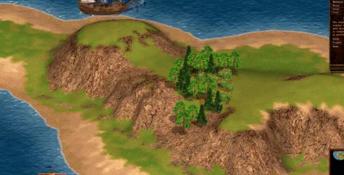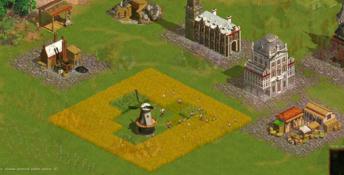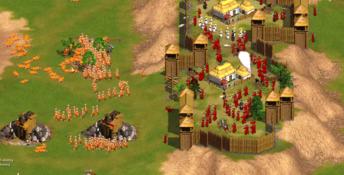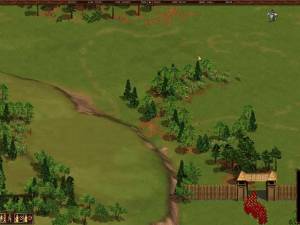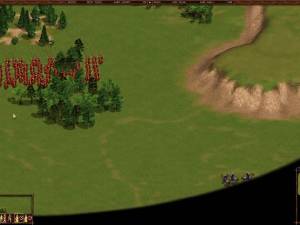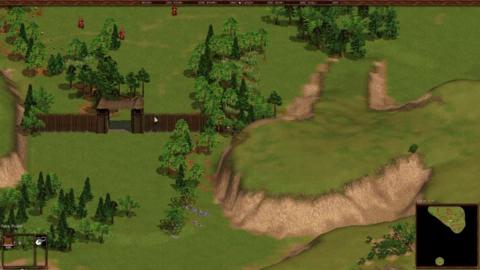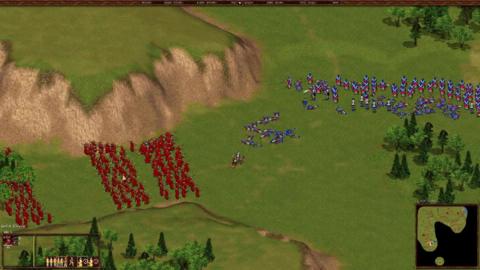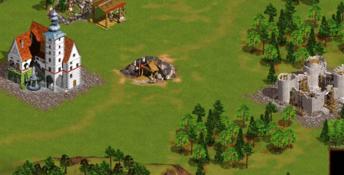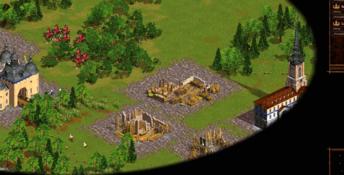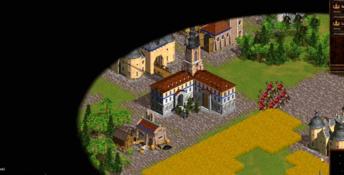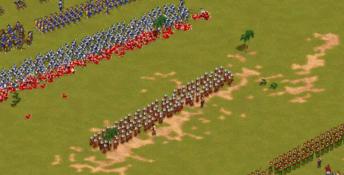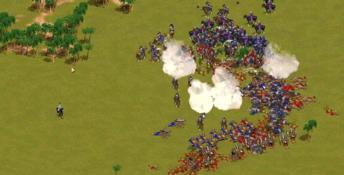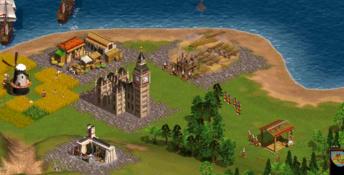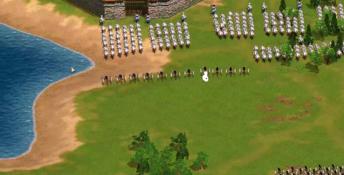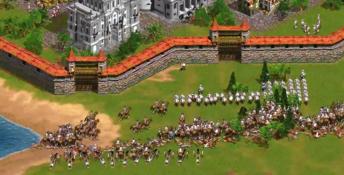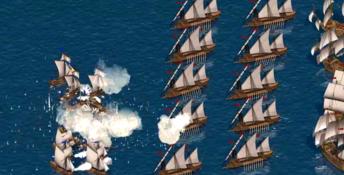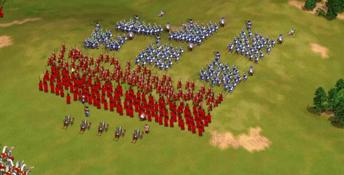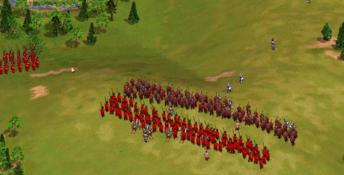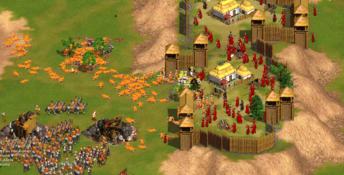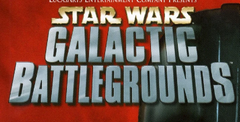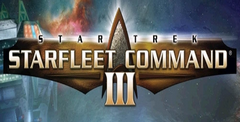Cossacks: European Wars
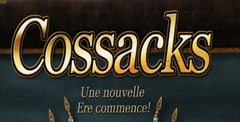
| a game by | Strategy First |
| Platform: | PC |
| Editor Rating: | 6/10, based on 1 review, 2 reviews are shown |
| User Rating: | 7.9/10 - 22 votes |
| Rate this game: | |
| See also: | Download Strategy Games, Games Like Red Alert, Cossacks Games |
Cossacks may seem like one of those games played by people who collect those Warfare Through The Ages -With Free Binder!' magazines, but there's a lot to enjoy about this historical based RTS. For a start, it's a true epic, set between the 16th and 18th centuries and focused on thousands of troops engaging in mass slaughter across 3D terrains. Unlike Shogun: Total War, these troops, which feature units like French Chasseur infantry and of course the Ukrainian Cossacks, can be moved individually as well as in large formations, adding an extra strategic element to proceedings. Also, unlike Shogun, Cossacks combines quite a bit of resource management, so you can create thriving cities full of peasants and gently ripening cornfields. With two expansion packs of its own, plus a spin-off game, American Conquest (which also has its own expansion), the Cossacks formula has certainly been well used and the engine now looks rather dated alongside fully 3D RTS games.
But if you're a hardcore strategy fan and a virgin to Cossacks, it's well worth investing five shiny coins for this.
Download Cossacks: European Wars

System requirements:
- PC compatible
- Operating systems: Windows 10/Windows 8/Windows 7/2000/Vista/WinXP
Game Reviews
Overview
The 17th and 18th centuries are often referred to as the Age of Enlightenment. Rarely do we hear about the almost constant warfare going on around the continent of Europe during these centuries. Cossacks, another real time strategy title, covers this time period and illustrates an era rarely covered in any media, let alone a computer game, especially in the US. This was a time when one of the most powerful armies marching hither and yon across the map belonged to... Sweden?! Yes, the perpetually neutral Swedes were fearsome fighters then, as the poor Poles can attest.
Gameplay, Controls, Interface
Cossacks is an entry in what has become known as the real time strategy genre. More appropriately called continuous action strategy, these games with no turns have settled on a general set of conventions. There is the oblique aspect main map showing part of the game area, a smaller map showing the entire game space and various information boxes that reflect the game situation. All are well executed here.
You control your peasants in the usual manner, directing them to work the land or build structures. The structures represent facilities needed to process resources, outlets for training and recruiting military units or focal points for investment in research. Your military units then can stay at home to protect your base of operations, or roam the map looking for conquest.
The game is comprehensive in its coverage of the period. There are 16 nations representing the armies that had a role in the conflicts of the time, including some unlikely entries like Algeria, Venice and the Piedmont (Northern Italy) in addition to more well-known nations like England, Prussia, France and Russia. The varying capabilities of the nationalities are represented by some unique units -- such as the game's namesake Cossacks, available to Russia and Ukraine (and other nations via the mercenary feature) -- and unit combat parameters.
Sadly though, history buffs can't stage any historic encounter they please -- the Turkish siege of Vienna in 1683, for instance -- because there's no scenario builder. The best you can do is put the two nations down in a random map game and try to capture the flavor of the encounter.
For the solitaire player, there are Campaigns -- linked single battle scenarios, such as the "War of Independence" (Ukrainian, not American) and France's "Thirty Years War." There are Single Missions, which are generalized scenarios based on situations like the "War for Resources" and a fight over an "Ancient Abbey." And of course, there are the Random Maps games. In multiplayer mode you and some networked friends can fight historical battles or generate random map deathmatches. Except for the random map, the types of games that can be played in either multiplayer or single-player modes are mutually exclusive. A single player can play campaigns and single missions, but these are not available in multiplayer. In multiplayer, you can play historical battles -- single battle scenarios based on real events -- but there are no campaigns or single missions. Happily, however, the random game generator is available in both modes.
Microsoft's Age of Empires series might be regarded as the benchmark for this type of game, since it's the most successful, so here's a list (not meant to be comprehensive) of some ways Cossacks differs from AoE, both for good and bad:
Ways that Cossacks falls a bit short of the standard: - Players used to AoE will be disappointed at the lack of information about what the cursor is hovering over when moving it around the main map. The resources especially give no clue as to what they are, either when clicked or hovered. We can surmise that we'll get wood from the clump of trees over there, but where do we get stone? Ah, must be that pattern of rocks strewn around that field. Yes, those holes in the ground support the mines, but which are iron and which are coal? You don't really know until you've built a mine or two. (Gold can be spotted fairly easily. There are little gold nuggets visible.) Some things must be learned by trial and error. - The peasants give no indication of what or how much resources they are carrying. The peasants don't "build and work," they build and stand there. Although there is a button for highlighting all idle peasants, there is no toggle for moving from one to the next. - Not all the civilizations get to progress to the 18th century. This seems an unnecessarily harsh cultural judgment in a computer game. If this is done for the sake of some obscure hyper-authenticity, then there are other details that should have been addressed or were missed. - It's not clear how to win a random game. It looks like you must wipe out every last resource and unit of the enemy -- not too much fun when half the time invested in the game is mopping up. - There's no diplomacy with the computer opponents.
Ways that Cossacks surpasses the standard: - Peasants, buildings and artillery can be captured. Buildings can be captured and either used or destroyed. Destruction of buildings doesn't happen instantly. Once you press the Delete button, the building catches fire and then slowly burns away its hit points, adding -- for those destruction fans out there -- atmosphere as your forces cut a swath through a nation. However, this also gives the original owner time to restore the building if he or she manages to recapture it. The owner can apply peasant power to rebuild a building. - Officers, drummers and formations. Create an officer and a drummer in your barracks and group your infantry into formations, then control them by clicking the officer, who serves as the conduit for all movement orders for the soldiers who are part of that formation. This introduces realistic period maneuvering that resembles true formation tactics and drill. There are only three formations, however -- rank, column and square (columns not for fast marching, but as an attack formation.) The fine points of drill are not left to the player ("Wheel left!") but the effect is the same -- magnificent uniformed masses marching and sweeping the field. Inexplicably, formations can be made using groups of certain numbers that seem to have no discernible pattern or relevance -- 15, 36, 96, 120. Formations can only be made in the designated denominations. So for instance, if you have 14 Janissaries, you can't form them up until you make one more. If you have between 17 and 35 of them, you'll be able to make one formation of 15 and the others will go unorganized. The leftovers can be thought of as replacements, perhaps. (Hint: work these odd units into the formation after it has taken losses by moving them close to it, disbanding the formation and then re-forming it.) - The economy is more important in that gold must be spent to maintain units. The concept of supply is introduced (though not that of supply lines) in that you must have iron and coal (representing the manufacturing of shot and powder) stockpiled in order for muskets and cannon to shoot. If your stock of these materials is exhausted, your forces may become helpless in the face of the enemy. - Mercenaries are expensive to maintain but quick to create in a pinch. Your diplomatic center can provide bought-and-paid-for units that will work for you as long as your gold supply holds out. - Resources do not run out. Though this may not be realistic for such items as coal or gold, this is more game practical in that these resources are, to an extent, an abstraction representing many other resources of fuel and metals. More appreciated is the fact that the wood is not exhausted. Trees grow back. Also, building the mill automatically provides many self-replenishing amber waves of grain for food (you still must assign peasants to work them), visually adding to the game and saving the player the need to rebuild farms.
Multiplayer support
Choose Multiplayer from the main menu. If your machine is connected to the Internet, choose "Internet games" from the menu and you're transported to an anonymous "master server" hosting games being played by Cossacks fans from around the world. At the time of this writing (exactly 9:15 Eastern US on 17 May 2001) there were 27 players online. Later on the number went up to 61. Be aware that these kinds of servers are wide open. There is no usage policy or stated rules, so be prepared for some standard, uncivil Internet behavior and crude language.
The game played well when tested on our little two-node wireless Symphony LAN. However, again, the multiplayer historical scenario played had no information about goals in the game and ended without a clear message about which side had prevailed.
Graphics
The graphics are clear and detailed. It's not difficult to differentiate between and among the units. The landscape is well defined. It looks like great effort went into creating individualized architectural styles for each of the cultures represented. Players will appreciate the pleasant appearance. Animations are varied and smooth.
Audio
As usual, there is a loop of somewhat overbearing music that can be disabled once you're sick of it. When you do, you can put on something like Schubert's Piano Trio in E flat (featured in the film Barry Lyndon, whose main character participates in the Seven Years War of 1756-63), Carmina Burana or some other appropriate piece to enhance your local playing atmosphere. Other game sounds include the birds in the trees, the peasants working at their tasks and a loud drummer that drums while the formations march, as well as the usual battle sounds.
System Requirements
Required: Pentium 200MHz, 32 MB RAM, Windows 95/98, 1 MB video RAM, 200 MB hard drive space, 8X CD-ROM drive, sound card, and DirectX 6.0.
Recommended: Pentium II 233 or better, 64 MB RAM, 4 MB video RAM, 200 MB hard drive space, and a 12X CD-ROM drive.
Documentation
The Tutorial campaign is useful, though some of the text is extraneous and downright senseless, perhaps having been translated from a language other than English. Use the tutorial to learn the game and the manual for reference about the buildings and units. The manual does have some interesting historical information, as does the online encyclopedia. But there's no way to get to the encyclopedia from inside the game! It can be brought up in a separate window before the game starts, however, and this is recommended. Keep it up while you're playing and you can ALT-TAB between them as needed. There are also missing items in the manual, which is unfortunately the norm these days, what with last minute changes and all. For instance, the multiplayer deathmatch comes with three different winning conditions, Score, Territory or Total Destruction. There's no explanation of these conditions that I could see. And there is no late-breaking information or errata in the readme text file.
There's a technology tree in the encyclopedia and it's reproduced in color in the manual. In the book, however, the icons representing the buildings and techs are virtually indecipherable, rendering the entire section beautiful but useless. The interactive tech tree in the encyclopedia is more helpful, as well as all the useful facts and research about the weapons and the period.
Originality/Cool Features
The most innovative aspect of the game is the formations feature. Large groups of soldiers can be controlled with considerably reduced effort and the flavor of the game is enhanced immensely. This is an age when drill emerged as a factor on the battlefield and this is accurately reflected here.
Bottom Line
Despite the omission of a scenario-building tool, this is a welcome addition to the wargame collector and the player with a desire to play a particular nation in this time period.
Snapshots and Media
PC Screenshots
See Also
Following more of a solid story line than its predecessors, many changes were made to this latest release including leaving behind the multiple races that were either non-factors or never seen on the TV series.

